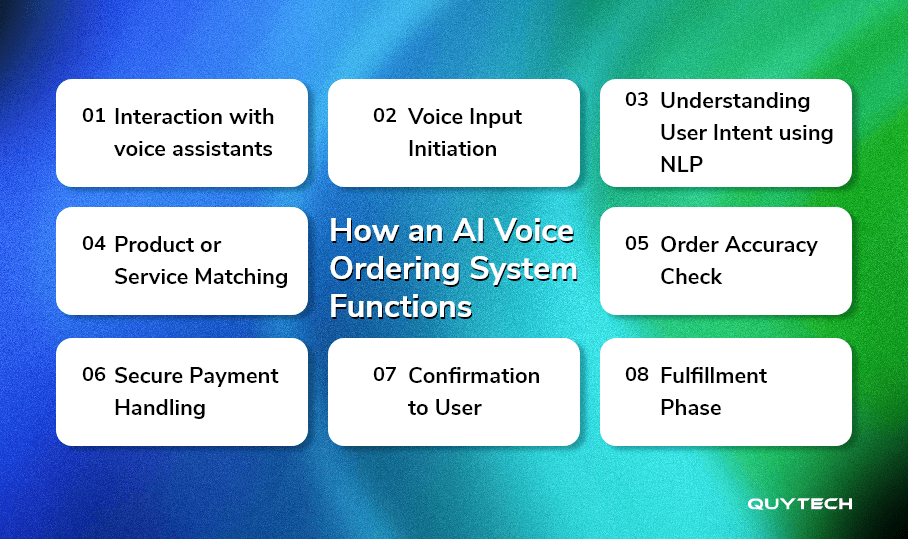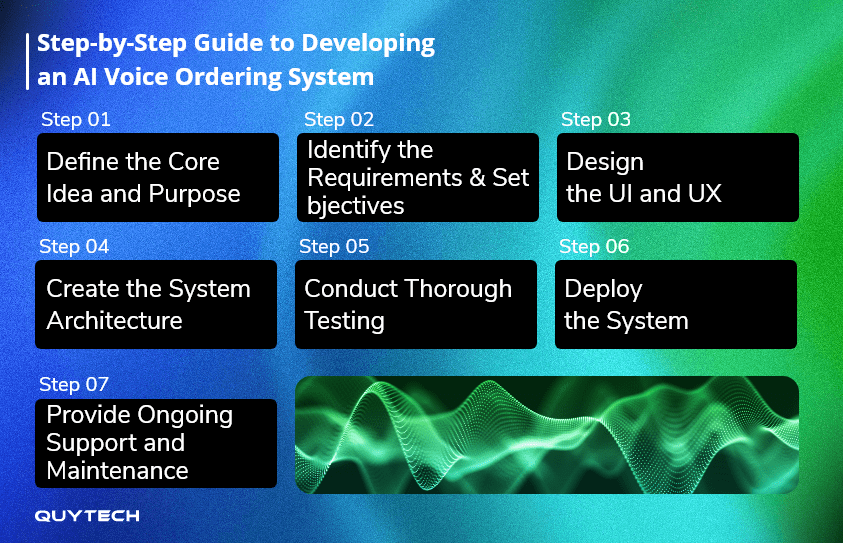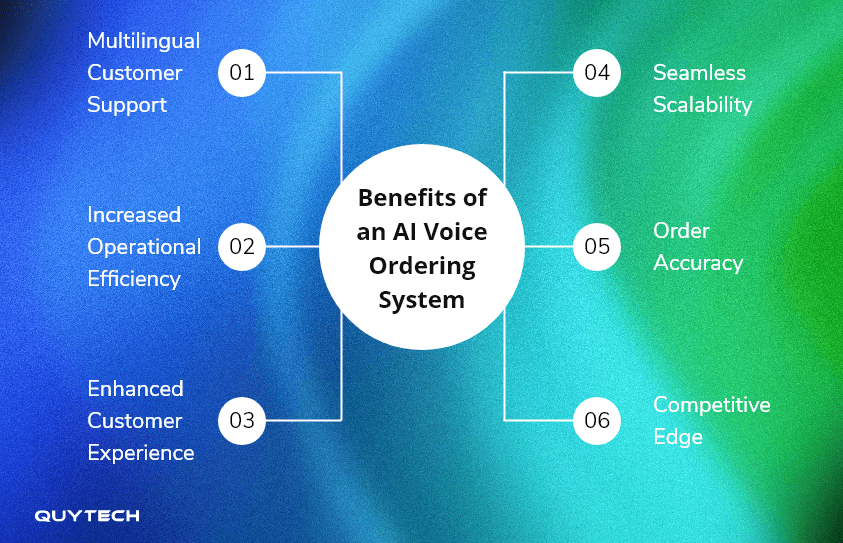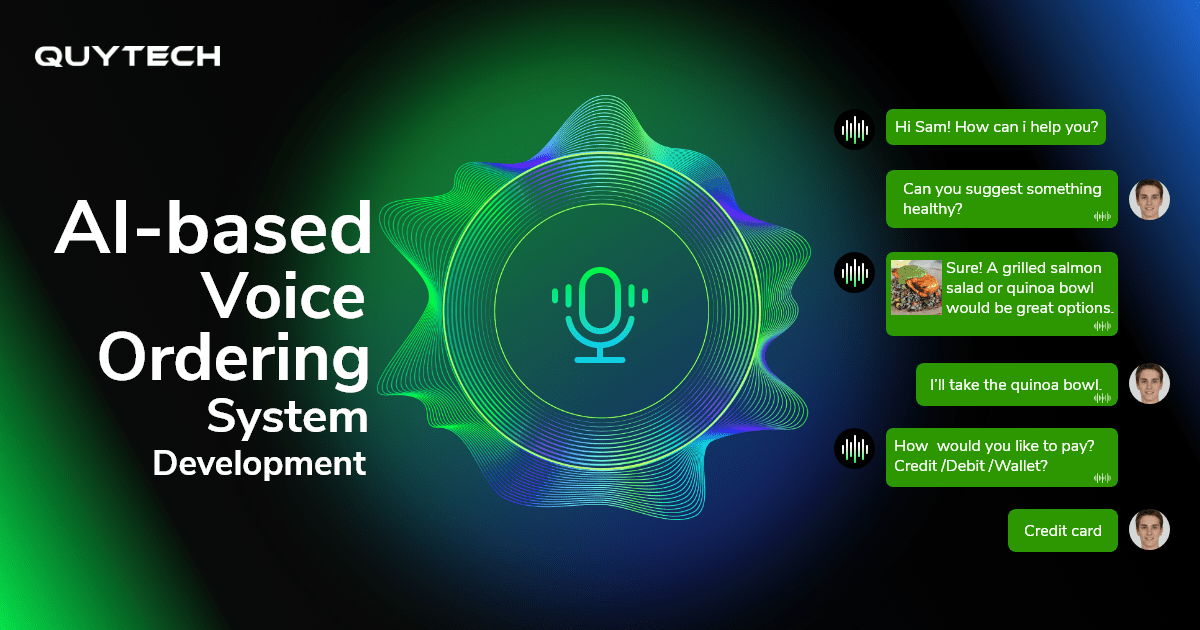Long waiting lines and lagging customer interface are some common customer nightmares for e-commerce and retail businesses. Adding the cherry on top with incorrect orders due to human error doesn’t just frustrate customers but also affects the business in terms of lost time, money, and customer loyalty. Now, imagine an interface so smooth that it allows the customers to place orders just by talking. That’s the magic of the AI Voice ordering system.
From smartwatches, e-commerce platforms, and in-car systems to voice assistants like Alexa, all offer their AI voice ordering system to process and track orders. It has become so prominent that it’s now a part of people’s routine.
If you run an e-commerce, retail, or any other business where speed, convenience, and customer experience are prioritized, then building an AI-based voice ordering system can be a game-changer. How? Well, read this blog that highlights features, the benefits, and the development process of the AI-based voice ordering system in detail.
Market Stats: AI-Powered Voice Ordering System
- The number of AI voice ordering systems set up by Taco Bell in the US reaches about 500.
- Based on the stats collected by Meticulous Research, the market segment for the world’s voice-controlled ordering and related technologies is expected to reach the bar of $26.8 billion in the year 2025.
- DoorDash has implemented AI voice ordering technology to manage incoming restaurant calls, addressing a significant gap where up to 50% of customer orders previously went unanswered.
What is an AI Voice Ordering System?
An AI-based voice ordering system is an interface that allows users to communicate and place orders by simply commanding. This is an innovative system that replaces the traditional typing commands system. It assists the customers and enhances their interaction with the system.
A voice command system can be the linking pin of communication between the end customers and the serving company. It targets businesses like Quick Service Restaurants, food chains, e-commerce platforms, customer service, logistics, etc.
An AI voice ordering system captures spoken orders, converts them into text, and then uses the text to determine user intent. Spoken order is then matched with the database, followed by payment processing. The system then confirms the order and passes it to the fulfillment system for execution.
How an AI Voice Ordering System Functions
An AI voice ordering system functions primarily when a user interacts with the system through verbal commands. It then carries forward the interaction through various inbuilt systems like natural language processing, voice recognition systems, and a database to provide the user with the required product or service to complete the transaction. The process begins with:

- Interaction with voice assistants: The user initiates the interaction by speaking their order into the interface through voice assistants or kiosks.
- Voice Input Initiation: The system then captures the command and converts it into text to transcribe the user’s speech.
- Understanding User Intent using NLP: After successful transcription of the speech, the NLP systems interpret the user’s intent for further processing.
- Product or Service Matching: The request is then matched with the available database to check for availability, pricing, specifications, etc.
- Order Accuracy Check: This step ensures that the order is complete and accurate. It ensures that there are no inconsistencies for further processing.
- Secure Payment Handling: Once the order is placed successfully, the system then goes on to the next phase, that is, the payment processing stage. In this phase, the system offers the user different options to make payments for their order.
- Confirmation to User: Once the payment has been completed, the system pings the user about their order confirmation.
- Fulfillment Phase: After completing the order placement and confirmation, the system sends it to the relevant fulfillment system. In this step, the order can be physically delivered, digitally activated, or fulfilled based on the nature of the product or service availed.
Role of AI in Voice Ordering System
Ever wondered how AI voice ordering systems can easily detect user intent even with diverse accents and languages? That’s made possible by AI, which enables machines to understand user intent accurately. AI-based voice ordering systems make use of a voice recognition system that helps in recognizing the voice of user and capturing it effectively. The natural language processing system aids in determining the user’s intent. These systems not only provide an accurate solution for the moment but also learn the behaviour of the user for future reference. This provides the user with a personalized experience.
The role of AI in voice ordering systems is not limited to simply recognizing the voice but also enhancing the user experience. It seamlessly integrates its different systems to provide the user with a streamlined ordering experience. Its integrated functionality makes it super easy and efficient for the user to place orders, process payments, and receive fulfillment.
The presence of AI reduces the chances of errors and improves the order accuracy, satisfying the users. Apart from this, the AI also offers support for users in multiple languages and offers query resolution as well. A full package of expert guidance is offered conversationally.
Read More: Face Recognition App Development
Step-by-Step Guide to Developing an AI Voice Ordering System
Building an AI voice ordering system comes with its own set of ideas, designs, strategies, and technology. In this guide, we will discover the steps to create an AI-based voice ordering system sequentially:

Define the Core Idea and Purpose
The first step comes when there is an idea for a system. The idea should have a purpose, like who it targets. For an AI voice ordering system, the targets could be the customers and how it would cater to their needs. This develops a track for the development process of the voice ordering system.
Identify the Requirements and Set Objectives
Identify the technical as well as business requirements for the system. This step can include defining technical requirements, like language processing systems, voice recognition technology, database, etc, and business requirements, like linking with payment and ecommerce platforms. It may also include regulatory compliance and integration requirements.
Setting objectives may include user interaction experiences, accuracy of voice recognition, time of response, etc.
Design the UI and UX
Design the user interface in a way that it’s easy to interact with and is intuitive. The user experience should be smooth, accurate, and have simple fallback options to offer a confusion-free, straightforward, and easy experience.
Create the System Architecture
Develop a backend architecture to support the various systems, like natural language processing, voice recognition, integration, payment platforms, database, etc. This structure ensures proper support, integration, and functionality of the voice ordering system.
Conduct Thorough Testing
Conducting thorough testing will help in understanding the user experience and identifying any deviations or add-ons. Thorough testing will allow you to check the performance accuracy of the system as a whole and the components separately.
Deploy the System
Launch the system in a live environment for routine interaction with the actual audience. Keep taking feedback and fixes if needed. Collect data from and plan scalability based on real experience.
Provide Ongoing Support and Maintenance:
Ensure that the system functions effectively and efficiently after launching. Keep adding new features and updating the systems to keep them up to date with the changes and advancements. Offer timely and regular maintenance.
Features of an AI Voice Ordering System
An AI voice ordering system works on providing a one-of-a-kind ordering experience to the users. Here are some of the features of an AI-based voice ordering system:
Voice Recognition
An AI voice ordering system comes with this amazing feature that makes giving commands as easy as having a normal conversation. This voice recognition captures the commands and then sends them forward for further processing.
Multiple Languages and Accents Support
This feature allows users with different languages to access the system easily, as it can understand different languages and accents. These features cater to a varied audience of different languages.
Personalized Ordering
AI voice ordering systems have a feature that collects data on past preferences of the user. This helps the system provide a personalized experience to the user.
Data Security
This feature protects the user’s data through end-to-end encryption and data regulation compliance. This provides data safety, ensuring no personal information is leaked to third parties.
Compatibility and Multi-platform Availability
This feature enables the use of voice ordering systems across various platforms as well as devices. This means that an AI voice ordering system can be accessed on different devices like mobiles, smart speakers, and different platforms like websites, applications, etc.
Safe Payments:
AI-based voice ordering systems ensure that the payments made are encrypted, secured, and not accessible by third parties. It incorporates multiple factor authentication systems to ensure payment safety.
Benefits of an AI Voice Ordering System
AI voice ordering systems are transforming the way businesses interact with customers. Below are the key benefits that make this technology a game-changer across industries.

Multilingual Customer Support
AI-based voice ordering systems can switch between multiple languages in real time. This helps in catering to a large and diverse customer base.
Increased Operational Efficiency
Artificial intelligence voice ordering system improves operational efficiency as the orders are placed without staff intervention. This lowers labour costs and allows businesses to handle high order values without increasing staff.
Enhanced Customer Experience
Voice ordering system replaces the traditional systems with a better interface, high-speed processing, and an intuitive experience. This gives a smooth and easy-to-interact interface, offering an improved customer experience.
Seamless Scalability
Being a setup based on AI, the voice ordering systems are scalable, as expanding to more locations does not require increasing staff.
Order Accuracy
AI voice ordering systems allow users to directly interact with the system, which reduces human errors like misheard orders or incorrect entries.
Competitive Edge
Adapting and employing the new technology advancements into business operations enables the business to gain a competitive advantage over its competitors.
Read More: AI Agents in E-Commerce: Everything You Need to Know
Technology Stack Needed for Developing an AI Voice Ordering System
Here’s a breakdown of the tech stack needed for developing an AI Voice ordering system:
| Component | Purpose | Technologies/Tools |
| 1. Voice Recognition (STT) | Converts spoken input into text | Google Cloud Speech-to-Text, Amazon Transcribe, Microsoft Azure Speech, Mozilla DeepSpeech, Whisper (OpenAI) |
| 2. Natural Language Processing (NLP/NLU) | Understands user intent and extracts meaning from text | Dialogflow, Amazon Lex, Microsoft LUIS, Rasa, spaCy, NLTK, GPT Lamma |
| 3. Backend Development | Manages business logic, API communication, and data handling | Python, Node.js, Java, Go; Django, Express.js, Spring Boot |
| 4. Frontend / User Interface | Provides a visual/voice interface for user interaction | React, React Native, Angular, Vue.js, Flutter, HTML/CSS/JavaScript |
| 5. Database | Stores user data, order history, and system logs | PostgreSQL, MySQL, MongoDB, Firebase, Redis |
| 6. Cloud platform | Hosts and scales services, provides compute and storage | AWS, Google Cloud Platform, Microsoft Azure |
| 7. Payment Integration | Facilitates secure online payments | Stripe, Razorpay, PayPal, Apple Pay, Google Pay |
| 8. Testing Tools | Ensures functionality, performance, and reliability across components | Postman (API Testing), Jest (JavaScript Testing), Mocha, Selenium (UI Testing), JMeter (Performance Testing), Cypress, Robot Framework (for end-to-end automation) |
| 9. Deployment & DevOps | Automates testing, integration, and deployment | Docker, Kubernetes, GitHub Actions, GitLab CI/CD, Jenkins |
Cost to Build an AI Voice Ordering System
The cost for building an AI Voice ordering system depends on a multiplicity of factors. Simpler installations with essential features could cost less, but if you need more sophisticated integrations and functionality, the cost might be higher.
Apart from these, the cost structure is also dependent on factors like the AI models used, resources allocated for deployment and testing, language support, voice recognition systems, etc.
Scalability and personalization features can also add to the cost, considering the feature weight they carry. A properly planned AI voice ordering system aligned with the business needs is worth investing in. It justifies the investment as it benefits the business by lowering its operational costs and improving customer satisfaction.
Read more: Top AI Business Ideas for Entrepreneurs in 2025 – Top 45 Ideas
How Quytech Can Help Build An AI-Based Voice Ordering System
Quytech brings a balanced combination of both AI expertise and industry experience that offers businesses a competitive edge over their competitors. Our service provides you with a feature-stacked personalized AI voice ordering system.
We have dedicated AI engineers who focus on customization to allow you to tailor the specifications of your AI-based voice ordering system to meet your exact needs.
From a basic AI model for your existing system to a fresh, innovative tech-savvy AI voice ordering system, Quytech can offer it all.
Read More: How to Develop an Intelligent AI Model
Conclusion
AI voice ordering systems are the revolution transforming the traditional typing systems. It not only saves time but is also a cost-effective way to conduct operations. By adapting to the latest technology like the AI-based voice ordering systems, not only can the business lower their operational costs and time, but also reach the advancement bar set by the emerging tech industry.
As technology is on the rise, AI-based voice ordering systems hold a bright future for businesses in the service industry. They are a great investment today and a competitive advantage for the future.
FAQ’s
For developing an AI-based voice ordering system, it can take about 4 to 6 months or more, depending on the specific requirements of your business.
Yes, it can be very beneficial for small retailers and startups to opt for AI voice ordering systems as they are operationally efficient and assist in managing workload smartly. This can also result in better customer satisfaction.
Yes, AI voice ordering systems allow users to make real-time modifications like increasing quantity, changing preferences, and cancelling orders.
Yes, unlike human agents, AI voice ordering systems can work 24/7. They provide uninterrupted service throughout the day as they do not depend on human staffing.



